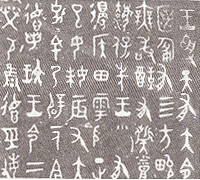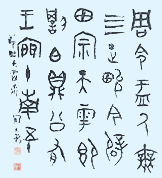The Great Menu Tripod was an important artifact of King Kang in the early Western Zhou Dynasty. It has an inscription of 19 lines and 291 words. The content records that King Kang of Zhou recalled the civil and military orders and conquered the Yin Dynasty and established the country. Later, the government and the public lost their troops due to alcoholism and the country perished. The Zhou Dynasty was taboo on wine and prospered. He ordered the pot to be cast. As a warning, he dedicated himself to assisting the royal family. It was unearthed in Li Village, Meixian County, Shaanxi Province in the early years of Daoguang's reign in the Qing Dynasty, and is now in the National Museum of China.

When talking about "The Great Cauldron", it is necessary to review early Chinese writing. It should be said that so far, the most well-documented characters are of course the oracle bone inscriptions from the Yin and Shang Dynasties. However, the oracle bone inscriptions have adopted the "Six Books" character construction method to create characters. It is a quite mature character and has been used since the Yin and Shang Dynasties. It is obvious that there should be a long period of germination and evolution of writing before it suddenly emerged in large numbers. But unfortunately, over the past two thousand years, what our Chinese writing looked like remains a mystery.
The Shang Dynasty was an era when oracle bone inscriptions and bronze inscriptions coexisted. Due to the different writing "crafts" of the two, they have always maintained their own style characteristics and aesthetic connotations. However, from the perspective of calligraphy, neither of them are ink marks, that is to say, they cannot most truly reflect the true appearance of merchants' daily writing. However, since archeology has not made new discoveries in this regard so far, the remaining ink marks They are also as few as morning stars, so people today can only look for clues about the ancients' pen usage in the two. In contrast, oracle bone inscriptions are mostly carved with a single sword, which makes it difficult to reflect the original appearance of the writing, while gold inscriptions can show more of the original ink writing and reflect the original writing style.
It should be said that the bronze casting technology of the Shang Dynasty was quite exquisite. However, the inscriptions at that time were very brief, and there were often only numbers on a vessel. Bronze vessels from the late Shang Dynasty have more characters.
The Western Zhou Dynasty was the most prosperous period for the development of bronze ware. After the Zhou people founded the country, they inherited the traditions of the Shang Dynasty in all aspects. On the one hand, they studied and absorbed a lot of Shang culture. At the same time, bronze production and inscription calligraphy also developed greatly with the further promotion of etiquette. Not only There are a considerable number of bronze vessels, and the inscriptions on each vessel are long and masterpieces from the beginning. For example, the "Ling Yi" written during the reign of King Cheng has 187 words. Compared with the "few words" inscriptions of the Shang Dynasty, it can be described as magnificent.
In terms of calligraphy style, the bronze inscriptions of the early Western Zhou Dynasty mostly inherited the legacy of the Yin and Shang Dynasties. The writing style is sharp from the beginning to the end, the structure is rigorous and precise, and the layout is uneven and full of dynamic beauty and rhythmic beauty. However, if broken down, it can be roughly divided into three categories: one is simple and plain, represented by "Ligui Ming"; the other is majestic and unrestrained, such as "Baoyou Ming", "Book of Dafang Ding Ming", etc.; The third one is solemn and strange, such as "He Zun Ming", "Kanghou Gui Ming", etc. Among these inscriptions, the one with the most outstanding style and the highest calligraphy achievements must be the "Da Yu Ding".

Although the "Da Yu Ding" belongs to the early Western Zhou Dynasty bronze inscriptions, its calligraphy style is rigorous, the knots and compositions are very simple and plain, and the pen is both square and round, serious and dignified, and has reached a very exquisite level. In addition, the shape of the vessel is huge and the shape is very simple. Dignified, vigorous and majestic, the work presents a majestic momentum and magnificent pattern, thus attracting the attention of the world.








